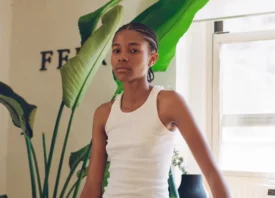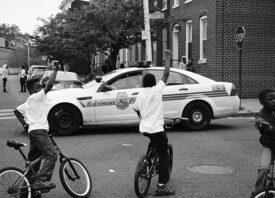Search this site
‘I Am Womxn’: A Photographer Celebrates Power and Pride Beyond the Patriarchy



DeLovie Kwagala was on a photoshoot when they heard Favour, a young aspiring photographer, tell the sitter, “My mum says girls can be whatever they want.” At the time, Kwagala was working on a project about womxn who inspired them, and Favour was assisting on some shoots, learning the ropes. But in that moment, Favour also became part of the project, titled I Am Womxn.
Kwagala, the first non-binary queer photographer and social activist in Uganda, grew up surrounded by womxn– “strong Womxn, who did whatever they needed to do to take care of and raise their families.” They looked up to these womxn, but at the same time, they saw how womxn were treated unjustly. “They got shamed for being too difficult and too independent to even be desired by men,” the artist remembers.
In the media, it was the same message. “When I occasionally got a glimpse of a newspaper stand on my walk to school, womxn only ever made the cover when they were criticized about their body image, dress code, or not being married,” they tell me.
“I grew up without a television or internet, but when I first bought a smartphone at eighteen and joined social media, it was like a brochure about how womxn looked and weighed–a whole new world that stirred huge insecurities within me. I went through a period of low self-esteem. It wasn’t an easy prison to break out of. But I kept searching until I found those who dared to be different and steer further away from societal normalcy.”
The initial seeds that would later blossom to become I Am Womxn were planted at the start of the #MeToo movement. “I watched a revolution of womxn regaining their confidence and voices, even when all the odds were placed against them,” they remember now. “I watched them take their power back, both online and in real life. For the first time, it was okay to speak up.”
Still, the fight for equality was far from over. Even at the height of the movement, the artist saw men take pains to avoid the topic. Meanwhile, blame was shifted onto victims and survivors, who were scrutinized and questioned. And eventually, discussions of #MeToo slowed and faded from the headlines.
“I was motivated to create something that would be a constant reminder of the power of the Pussy,” Kwagala continues. “At the same time, I wanted to defy social standards around body image and champion the inclusion of those that are constantly questioned about the validity of their womxnhood. The photographs became an affirmation that we all stand together.”
The use of “womxn,” in Kwagala’s title and this story, is intentional. “The spelling womxn is the more inclusive and alternative term to the word ‘woman’ or ‘women,’” they explain. “It was introduced back in the 1970s by intersectional feminists to avoid perceived sexism, to include trans womxn, and also to have a term that didn’t include ‘man’ or ‘men’.
“I personally found it fitting in this age and era, with the rise of pronoun usage and their importance. I find it liberating because not every womxn uses the ‘she’ pronouns; some are they/them. The term womxn simply gives room to evolve into whoever you are with no limitations.”
The womxn they chose to be part of the project have unique experiences and identities, though they’re all united by resilience. They include the photographer’s family, friends, and lovers. “I needed the project to start at home, with the womxn who inspired me daily and those who looked up to me, to highlight the womxn who looked like my mother, to blur our differences and similarities and simply be,” Kwagala says.
That idea of “simply being” formed the foundation for all the photo sessions. “All of my personal projects center on the freedom of self-direction, and this wasn’t any different,” the photographer says. “First thing, I ask my participants is to pose in the way they want to be perceived by the world. They choose what to wear, makeup or no makeup, and honestly, most of the time is spent catching up about life and having conversations around their understanding of the project and what it means to be a part of it.”
For the project, Kwagala, who used to do tribal body painting at festivals and events, brought along the body paint. Their sitters chose what to use and how. Some painted their bodies, and others did not.

“Most of the womxn I photographed naked had never even dreamt of doing it,” the artist remembers. “Samantha had spent all her life being called fat, and as we photographed, she voluntarily took off layer by layer. She said it was time to take her power back, to show the world that her fatness wasn’t going to stop her from being great and showing up as she is.
“After the session, she cried and hugged me for letting her simply be. She later sent me a message that said, ‘De, you sparked something in me today that I didn’t know I needed. You held space for my vulnerability. I didn’t walk away as I came, but with a new sense of bravery and confidence.’ I cried because if there is a purpose that I want from my work, it is exactly that feeling. Samantha gave my work a purpose that day.”
Built from the foundation forged by womxn and non-binary artists who came before, Kwagala’s work is now paving the way for the next generation. The portrait they made with Favour, the aspiring photographer, is the first in the I Am Womxn series. “At the time, she was starting to notice more and more about gender roles in society, so I was constantly reminding her that girls can do anything boys do,” Kwagala tells me. “I reminded her that there is no such thing as gender and that there shouldn’t be any limitations around having to choose between wanting to be Spiderman or Wonder Woman. You can be both.”




DeLovie Kwagala is a member of Black Women Photographers, a global community bringing together Black womxn and non-binary photographers. To learn more about Black Women Photographers, visit their website, and follow along on Instagram at @blackwomenphotographers. All images © DeLovie Kwagala.


